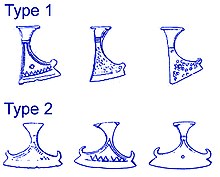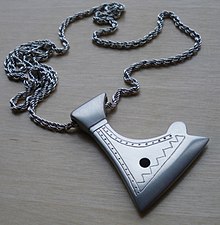

Axes of Perun, also called "hatchet amulets", are archaeological artifacts worn as a pendant and shaped like a battle axe in honor of Perun, the supreme deity of Slavic religion. They are counterparts to Nordic Mjolnir amulets. They are mostly found in modern day Serbia, Russia, Ukraine, Belarus, Poland, Lithuania, Latvia and parts of Scandinavia. Connection with the Slavic pre-Christian god Perun was made by V. P. Darkevich, although some authors prefer the association with Norse material culture.[1]


The axes range in length from 4 to 5.5 cm (1.6 to 2.2 in), and blade width from 2.8 to 4 cm (1.1 to 1.6 in). Bronze is the most common material of their construction. Most have been dated between the 11th and 12th century, and over 60 specimens have been collected.
Two basic designs of the axe have been found throughout Russia and its boundaries.
Specimens of both designs include a hole in the centre of the blade, and both have been decorated with zigzag lines, representing lightning or more likely imitating inlaid ornamentation patterns of real axes, near the edge of the blade.